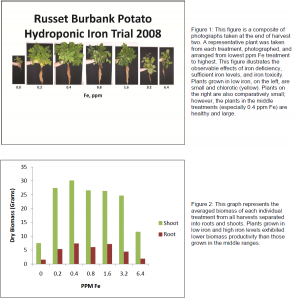Joshua Buck and Dr. Bryan Hopkins, Department of Plant and Wildlife Sciences
As world population increases the demand on agriculture to produce a sufficient amount of food has dramatically increased. However, agricultural lands in the US and worldwide are quickly disappearing to further urban development. Therefore it is essential that agricultural practices are reviewed and improved to insure a maximum yield from minimum resources.
There are approximately 5,500 potato growers in the United States producing over $2.6 billion worth of potatoes. The impact of potatoes is at least equally important worldwide and especially important in many developing countries. The majority of the U.S. potato industry farms are on productive alkaline, calcareous soils in the Western United States. These calcareous conditions potentially lead to iron deficiencies in the potato plants, and it is necessary to know if the addition of iron fertilizers would significantly affect potato yield and production.
Based on the results we altered our objectives in this study and focused on developing a system to test iron nutrition in potato hydroponically. To accomplish significant iron fertilizer research it is necessary to identify deficient, optimum, and toxic levels of iron. Without knowing plant responses or appropriate iron requirements fertilization research and recommendations are meaningless.
Plants were grown in a chelator-buffer hydroponic solution1 that provided all of the essential nutrients required by plants. Iron was removed from these solutions and subsequently added in specific varying levels to ultimately identify deficient, optimum, and toxic iron levels in Russet Burbank potato. Eight plants were grown in one of seven iron treatments, 0 parts per million iron (ppm Fe), 0.2 ppm Fe, 0.4 ppm Fe, 0.8 ppm Fe, 1.6 ppm Fe, 3.2 ppm Fe, and 6.4 ppm Fe. These treatments were each replicated four times, resulting in a total of 224 plants.
Through the course of the study each treatment under went three harvests; five plants were removed in the first harvest from each pot, two in the second, three in the third. After each harvest plant tops were separated from the roots, and both were oven dried for 48 hours. After drying the plants were weighed to achieve a dry biomass in grams. These masses were then averaged and plotted on a graph to identify the effect of varying iron levels on biomass production (Fig. 2).
There were significant observable effects of the various iron treatments even before biomass was determined (Fig. 1). Plants grown with 0 ppm Fe and 0.2 ppm Fe, exhibited stunted growth and intense chlorosis. Plants high in iron, 3.2 ppm to 6.4 ppm also exhibited poor growth. The analysis of the biomass of the plants grown in varying iron levels confirmed visual observations (Fig. 2). The data suggests that plants growing in an environment containing 0-0.2 ppm iron will exhibit iron deficiencies that will affect biomass, the optimum levels for iron are 0.4ppm, and plants growing in an environment containing 3.2-6.4 ppm iron will exhibit iron toxicity that will affect biomass.
This study successfully developed a system to test iron nutrition in potatoes hydroponically. Once published, this data will allow other researchers to study the effects of iron fertilizers on plants experiencing iron deficiency, toxicity, or sufficient iron levels. Growers in turn will be able to use this information to enhance yields, or to save money and the environment by avoiding unnecessary iron fertilizer use.

